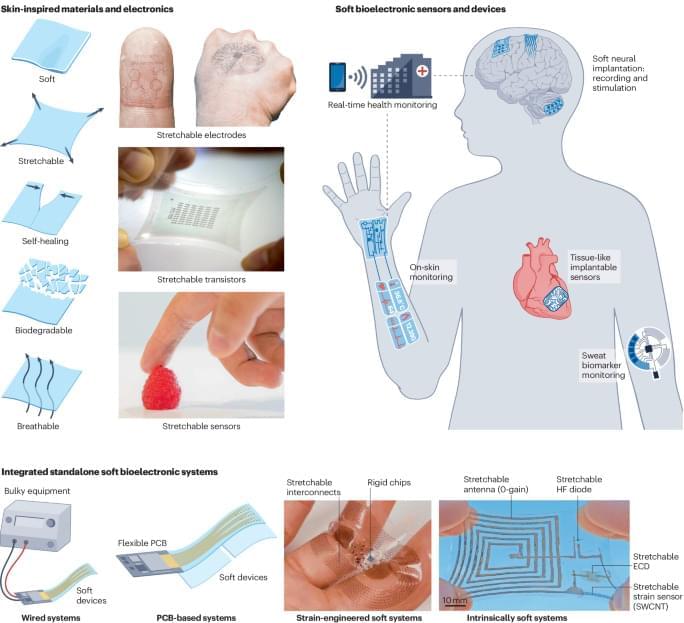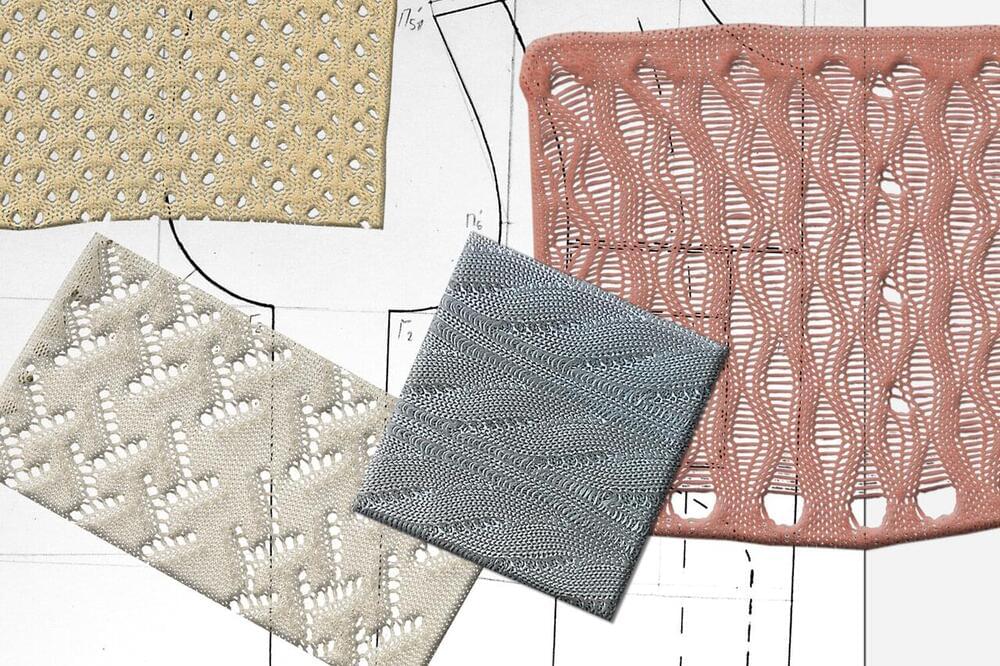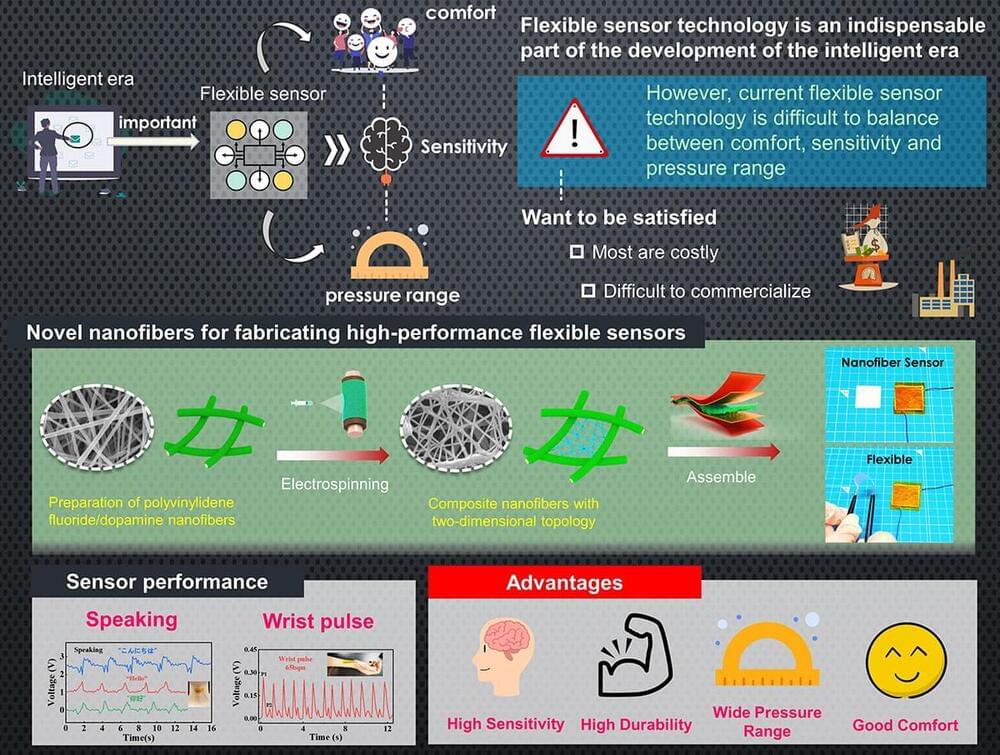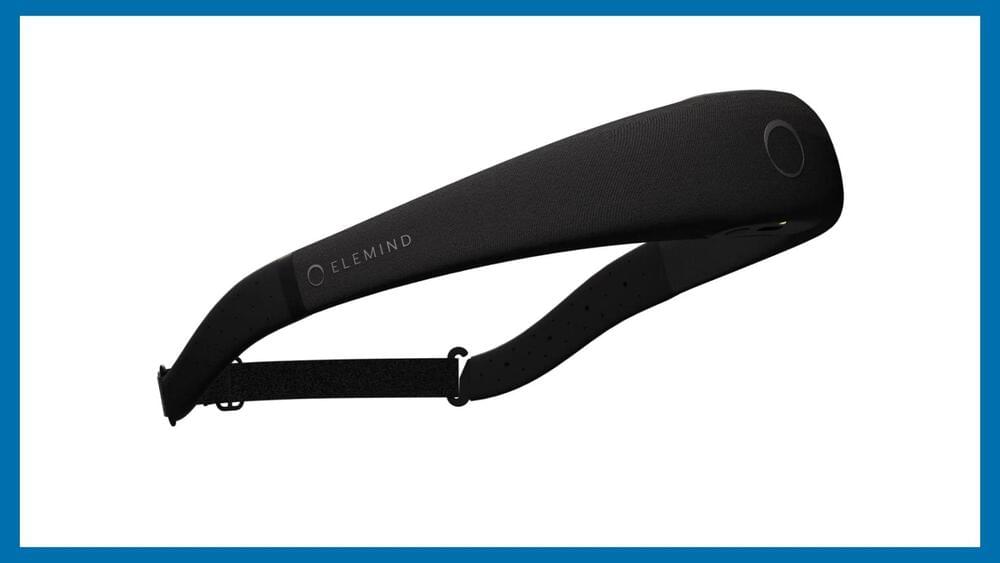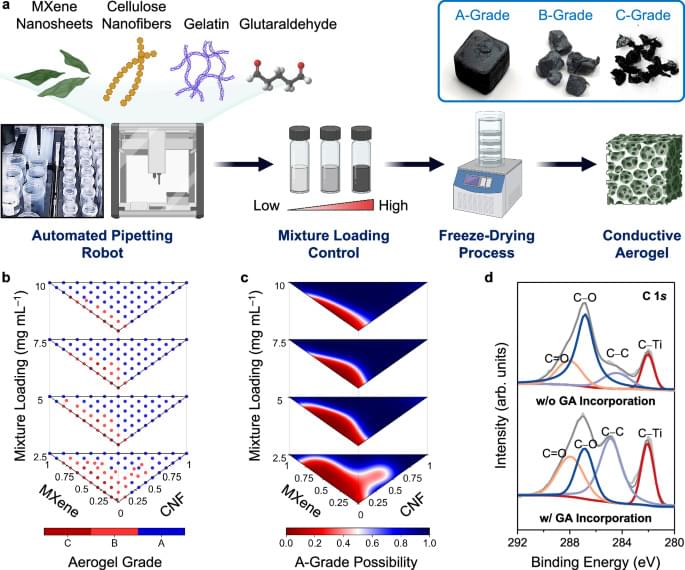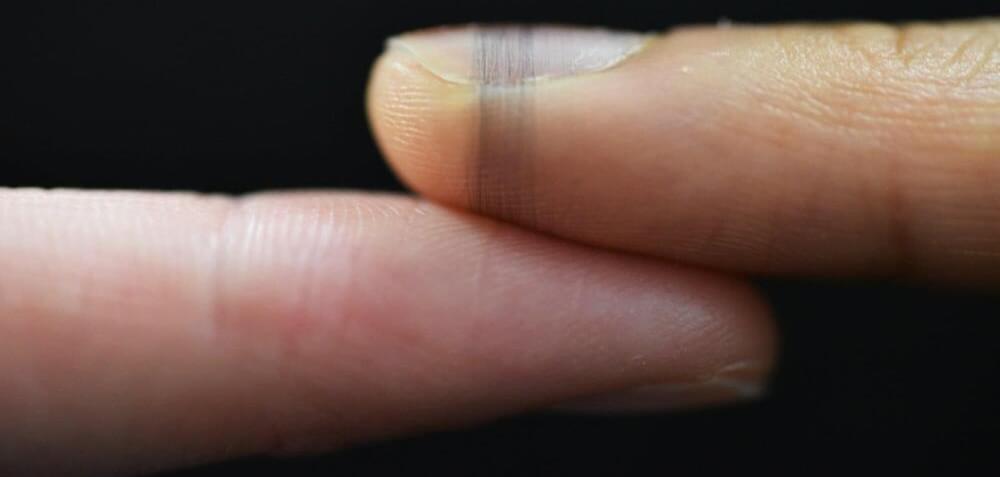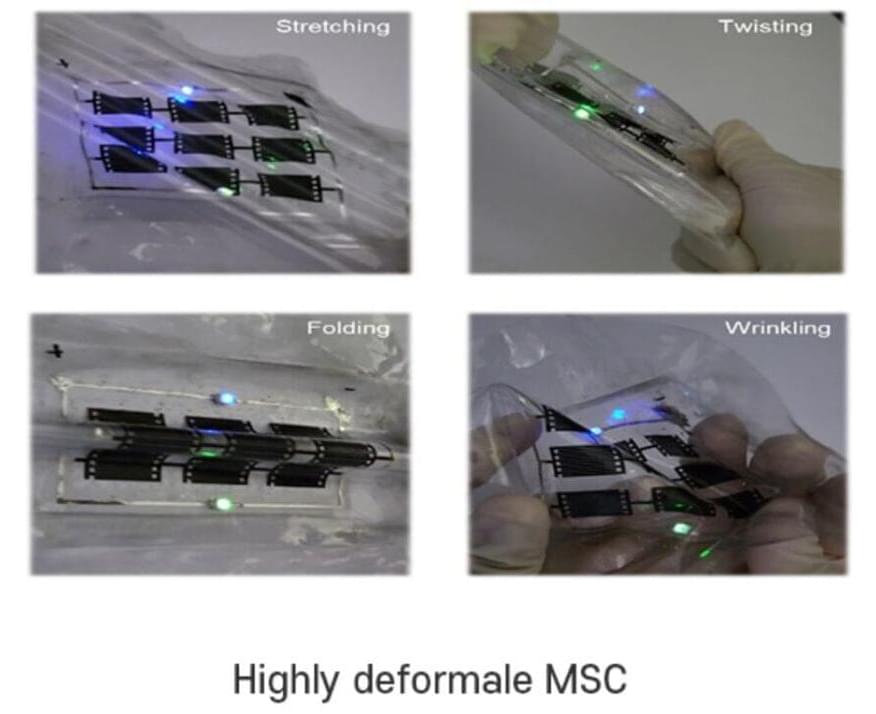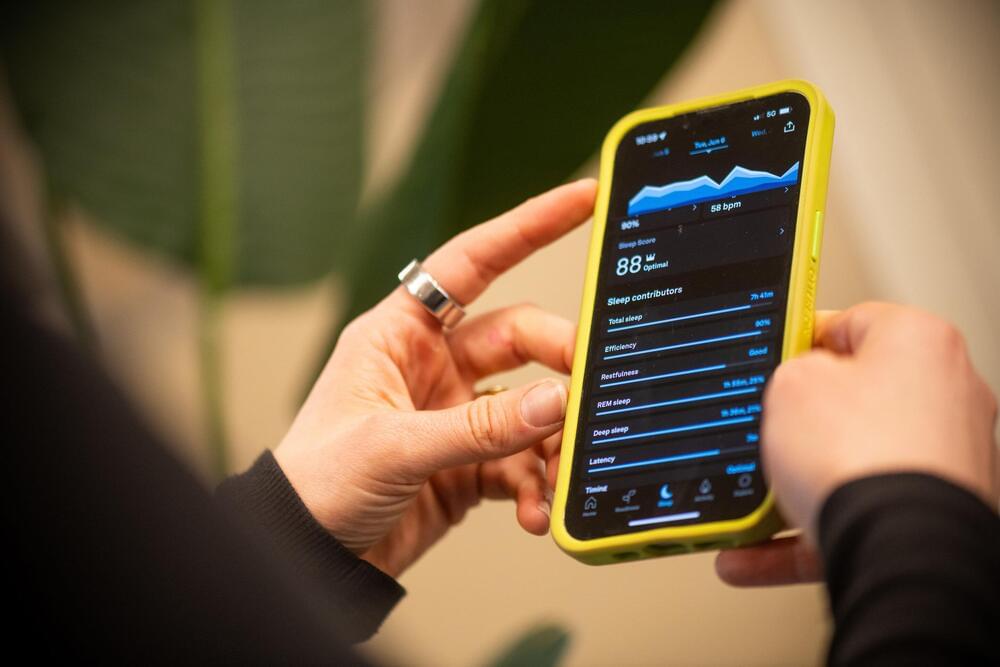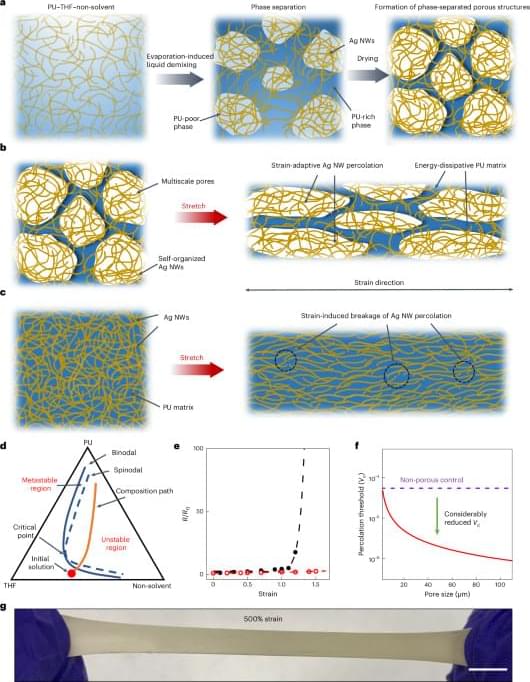Soft bioelectronic devices are made from polymer-based and hybrid electronic materials that form natural interfaces with the human body. In this Review, the authors present recent developments in soft bioelectronic sensors and actuators, and discuss system-level integration for wearable and implantable medical applications.
Category: wearables – Page 7
The only problem with plastic profusion is that “recycling” it is at a “caveman’s” level!
In considering materials that could become the fabrics of the future, scientists have largely dismissed one widely available option: polyethylene.
The stuff of plastic wrap and grocery bags, polyethylene is thin and lightweight, and could keep you cooler than most textiles because it lets heat through rather than trapping it in. But polyethylene would also lock in water and sweat, as it’s unable to draw away and evaporate moisture. This antiwicking property has been a major deterrent to polyethylene’s adoption as a wearable textile.
Now, MIT engineers have spun polyethylene into fibers and yarns designed to wick away moisture. They wove the yarns into silky, lightweight fabrics that absorb and evaporate water more quickly than common textiles such as cotton, nylon, and polyester.
Flexible piezoelectric sensors are essential to monitor the motions of both humans and humanoid robots. However, existing designs are either are costly or have limited sensitivity. In a recent study, researchers from Japan tackled these issues by developing a novel piezoelectric composite material made from electrospun polyvinylidene fluoride nanofibers combined with dopamine. Sensors made from this material showed significant performance and stability improvements at a low cost, promising advancements in medicine, healthcare, and robotics.
The world is accelerating rapidly towards the intelligent era—a stage in history marked by increased automation and interconnectivity by leveraging technologies such as artificial intelligence and robotics. As a sometimes-overlooked foundational requirement in this transformation, sensors represent an essential interface between humans, machines, and their environment.
However, now that robots are becoming more agile and wearable electronics are no longer confined to science fiction, traditional silicon-based sensors won’t make the cut in many applications. Thus, flexible sensors, which provide better comfort and higher versatility, have become a very active area of study. Piezoelectric sensors are particularly important in this regard, as they can convert mechanical stress and stretching into an electrical signal. Despite numerous promising approaches, there remains a lack of environmentally sustainable methods for mass-producing flexible, high-performance piezoelectric sensors at a low cost.
The Elemind headband is a soft, lightweight, and flexible wearable designed to be worn throughout the night, regardless of one’s sleeping position. It can collect information using brainwaves and pairs with a smartphone, where users can find details about their sleep patterns.
Where the headband is effective is its ability to use neuromodulation to impact the brainwaves, directing them from wakeful patterns to those of deeper sleep. “Elemind works like noise-cancellation for the brain. You can switch off the world, switch off the stress, and go to sleep faster,” explained Meredith Perry, the CEO and co-founder of Elemind.
Conductive aerogels have gained significant research interests due to their ultralight characteristics, adjustable mechanical properties, and outstanding electrical performance1,2,3,4,5,6. These attributes make them desirable for a range of applications, spanning from pressure sensors7,8,9,10 to electromagnetic interference shielding11,12,13, thermal insulation14,15,16, and wearable heaters17,18,19. Conventional methods for the fabrication of conductive aerogels involve the preparation of aqueous mixtures of various building blocks, followed by a freeze-drying process20,21,22,23. Key building blocks include conductive nanomaterials like carbon nanotubes, graphene, Ti3C2Tx MXene nanosheets24,25,26,27,28,29,30, functional fillers like cellulose nanofibers (CNFs), silk nanofibrils, and chitosan29,31,32,33,34, polymeric binders like gelatin25,26, and crosslinking agents that include glutaraldehyde (GA) and metal ions30,35,36,37. By adjusting the proportions of these building blocks, one can fine-tune the end properties of the conductive aerogels, such as electrical conductivities and compression resilience38,39,40,41. However, the correlations between compositions, structures, and properties within conductive aerogels are complex and remain largely unexplored42,43,44,45,46,47. Therefore, to produce a conductive aerogel with user-designated mechanical and electrical properties, labor-intensive and iterative optimization experiments are often required to identify the optimal set of fabrication parameters. Creating a predictive model that can automatically recommend the ideal parameter set for a conductive aerogel with programmable properties would greatly expedite the development process48.
Machine learning (ML) is a subset of artificial intelligence (AI) that builds models for predictions or recommendations49,50,51. AI/ML methodologies serve as an effective toolbox to unravel intricate correlations within the parameter space with multiple degrees of freedom (DOFs)50,52,53. The AI/ML adoption in materials science research has surged, particularly in the fields with available simulation programs and high-throughput analytical tools that generate vast amounts of data in shared and open databases54, including gene editing55,56, battery electrolyte optimization57,58, and catalyst discovery59,60. However, building a prediction model for conductive aerogels encounters significant challenges, primarily due to the lack of high-quality data points. One major root cause is the lack of standardized fabrication protocols for conductive aerogels, and different research laboratories adopt various building blocks35,40,46. Additionally, recent studies on conductive aerogels focus on optimizing a single property, such as electrical conductivity or compressive strength, and the complex correlations between these attributes are often neglected to understand37,42,61,62,63,64. Moreover, as the fabrication of conductive aerogels is labor-intensive and time-consuming, the acquisition rate of training data points is highly limited, posing difficulties in constructing an accurate prediction model capable of predicting multiple characteristics.
Herein, we developed an integrated platform that combines the capabilities of collaborative robots with AI/ML predictions to accelerate the design of conductive aerogels with programmable mechanical and electrical properties (see Supplementary Fig. 1 for the robot–human teaming workflow). Based on specific property requirements, the robots/ML-integrated platform was able to automatically suggest a tailored parameter set for the fabrication of conductive aerogels, without the need for conducting iterative optimization experiments. To produce various conductive aerogels, four building blocks were selected, including MXene nanosheets, CNFs, gelatin, and GA crosslinker (see Supplementary Note 1 and Supplementary Fig. 2 for the selection rationale and model expansion strategy). Initially, an automated pipetting robot (i.e., OT-2 robot) was operated to prepare 264 mixtures with varying MXene/CNF/gelatin ratios and mixture loadings (i.e.
While wearable technologies with embedded sensors, such as smartwatches, are widely available, these devices can be uncomfortable, obtrusive and can inhibit the skin’s intrinsic sensations.
“If you want to accurately sense anything on a biological surface like skin or a leaf, the interface between the device and the surface is vital,” said Professor Yan Yan Shery Huang from Cambridge’s Department of Engineering, who led the research. “We also want bioelectronics that are completely imperceptible to the user, so they don’t in any way interfere with how the user interacts with the world, and we want them to be sustainable and low waste.”
There are multiple methods for making wearable sensors, but these all have drawbacks. Flexible electronics, for example, are normally printed on plastic films that don’t allow gas or moisture to pass through, so it would be like wrapping your skin in plastic film. Other researchers have recently developed flexible electronics that are gas-permeable, like artificial skins, but these still interfere with normal sensation, and rely on energy-and waste-intensive manufacturing techniques.
Scientists use laser ablation technology to develop a deformable micro-supercapacitor. Professor Jin Kon Kim and Dr. Keon-Woo Kim from the Department of Chemical Engineering at Pohang University of Science and Technology (POSTECH), in collaboration with Dr. Chanwoo Yang and Researcher Seong Ju Park from the Korea Institute of Industrial Technology (KITECH), have achieved a significant breakthrough in developing a small-scale energy storage device capable of stretching, twisting, folding, and wrinkling. Their research has been published in the electronic engineering journal, npj Flexible Electronics.
The advent of wearable technology has brought with it a pressing need for energy storage solutions that can keep pace with the flexibility and stretchability of soft electronic devices.
Micro supercapacitors (MSCs) have emerged as a promising candidate for deformable energy storage, due to high-power density, rapid charging, and long cycle life.
What if changes in a person’s stress levels could be detected while they sleep using wearable devices? A new study by University of Vermont researchers published in PLOS Digital Health is the first to find changes in perceived stress levels reflected in sleep data—an important step towards identifying biomarkers that may help flag individuals in need of support.
Given how critical sleep is to physical and mental health, the research team suspected signals might exist in sleep data, says Laura Bloomfield, a research assistant professor of mathematics and statistics and lead author of the study. “Changes in stress are visible.”
When parsing baseline sleep data, the researchers found “consistent associations” between people’s perceived stress scores and factors such as total sleep time, resting heart rate and heart rate variability, and respiratory rate.
An in situ phase-separation method at microscale level creates stretchable superelastic porous nanocomposite conductors, reduces conductive filler usage and enables strain-resilient wireless wearable and implantable bioelectronics.
